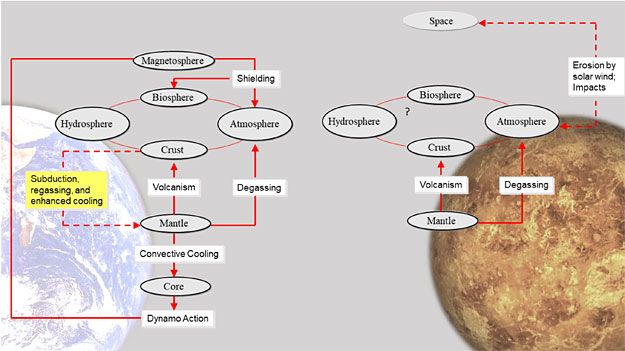The Long-term Evolution Of The Atmosphere Of Venus: Processes And Feedback Mechanisms

In this chapter, we focus on the long-term evolution of the atmosphere of Venus, and how it has been affected by interior/exterior cycles. The formation and evolution of Venus’s atmosphere, leading to the present-day surface conditions, remain hotly debated and involve questions that tie into many disciplines.
Here, we explore the mechanisms that shaped the evolution of the atmosphere, starting with the volatile sources and sinks. Going from the deep interior to the top of the atmosphere, we describe fundamental processes such as volcanic outgassing, surface-atmosphere interactions, and atmosphere escape.
Furthermore, we address more complex aspects of the history of Venus, including the role of meteoritic impacts, how magnetic field generation is tied into long-term evolution, and the implications of feedback cycles for atmospheric evolution.
Finally, we highlight three plausible end-member evolutionary pathways that Venus might have followed, from the accretion to its present-day state, based on current modeling and observations.
In a first scenario, the planet was desiccated early-on, during the magma ocean phase, by atmospheric escape.
In a second scenario, Venus could have harbored surface liquid water for long periods of time, until its temperate climate was destabilized and it entered a runaway greenhouse phase. In a third scenario, Venus’s inefficient outgassing could have kept water inside the planet, where hydrogen was trapped in the core and the mantle was oxidized.
We discuss existing evidence and future observations/missions needed to refine our understanding of the planet’s history and of the complex feedback cycles between the interior, surface, and atmosphere that operate in the past, present or future of Venus.
Cedric Gillmann (1), M.J. Way (2 and 3), Guillaume Avice (4), Doris Breuer (5), Gregor J. Golabek (6), Dennis Honing (7 and 8), Joshua Krissansen-Totton (9), Helmut Lammer (10), Ana-Catalina Plesa (5), Moa Persson (11), Joseph G. O’Rourke (12), Arnaud Salvador (13), Manuel Scherf (14), Mikhail Yu. Zolotov (15) ((1) Rice University, Department of Earth, Environmental and Planetary Sciences, Houston, USA, (2) NASA Goddard Institute for Space Studies, 2880 Broadway, New York, USA, (3) Theoretical Astrophysics, Department of Physics and Astronomy, Uppsala University, Uppsala, Sweden, (4) Universite de Paris, Institut de physique du globe de Paris, CNRS, Paris, France, (5) DLR, Institute of Planetary Research, Berlin, Germany, (6) Bayerisches Geoinstitut, University of Bayreuth, Bayreuth, Germany, (7) Potsdam Institute for Climate Impact Research, Potsdam, Germany, (8) Department of Earth Sciences, VU Amsterdam, The Netherlands, (9) Department of Astronomy and Astrophysics, University of California, Santa Cruz, CA, USA, (10) Space Research Institute, Austrian Academy of Sciences, Graz, Austria, (11) Institut de Recherche en Astrophysique et Planetologie, Centre National de la Recherche Scientifique, Universite Paul Sabatier-Toulouse III, Centre National d’Etudes Spatiales, Toulouse, France, (12) School of Earth and Space Exploration, Arizona State University, Tempe, AZ, USA, (13) Department of Astronomy and Planetary Science, Northern Arizona University, Flagstaff, AZ, USA, (14) Space Research Institute, Austrian Academy of Sciences, Institute of Physics, University of Graz, Institute for Geodesy, Technical University, Graz, Austria, (15) Arizona State University, Tempe, USA)
Subjects: Earth and Planetary Astrophysics (astro-ph.EP); Geophysics (physics.geo-ph)
Cite as: arXiv:2204.08540 [astro-ph.EP] (or arXiv:2204.08540v1 [astro-ph.EP] for this version)
Submission history
From: Cedric Gillmann
[v1] Mon, 18 Apr 2022 19:54:44 UTC (9,587 KB)
https://arxiv.org/abs/2204.08540
Astrobiology,








